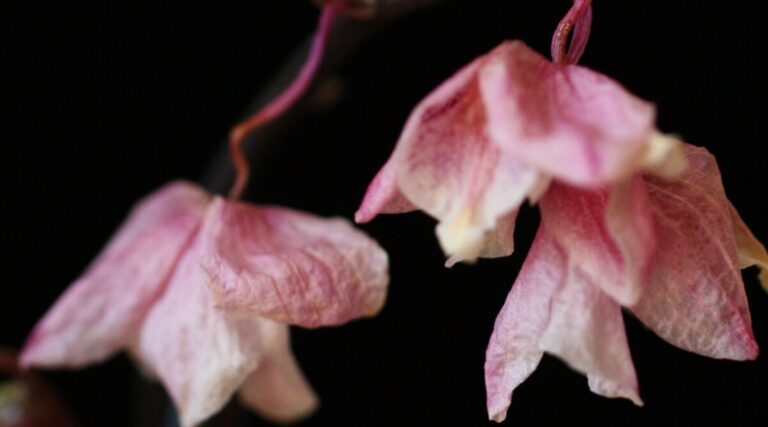It’s worrying when the beautiful blooms on your prized orchid start to droop and wilt. Flower drop is normal as blooms age but accelerated drooping can signal problems. Don’t panic – in most cases the issue can be fixed with a few orchid care adjustments.
Common Causes of Drooping Orchid Flowers
Several cultural factors can cause orchid blooms to go limp and start pointing downward Here are some of the most likely culprits
Underwatering
Lack of adequate moisture is a prime reason for droopy orchid flowers. The blooms are the first sign of wilt before leaves start to wrinkle. Make sure the potting mix is not bone dry before watering.
Overwatering
Excess moisture around the roots can also cause flower droop Root rot from too much water limits the plant’s ability to take up water, Let the growing medium dry out between waterings
Low Humidity
Orchids prefer 40-60% ambient humidity. In dry indoor air, flowers lose turgor pressure and start to droop. Misting, pebble trays, and humidifiers can raise moisture levels.
Light Changes
Moving an orchid to a spot with more or less light than it’s used to can induce moisture stress and wilting blooms. Keep lighting consistent.
Temperature Fluctuation
Rapid temperature swings or exposure to heat vents causes orchid flowers to wilt prematurely. Keep your orchid in an area with stable temps around 65-80°F.
Irregular Fertilizing
Orchids need regular dilute fertilizer to support blooming. Nutrient deficiencies cause weak flower stems that start to bend and droop over.
Bacterial or Fungal Infection
Bacterial and fungal diseases like orchid blight cause rapidly spreading flower wilt. Inspect plants closely and isolate any that show signs of infection. Discard diseased orchids.
Physical Damage
If flowers on only one part of the orchid are drooping, the blooms may have been bumped or hit by something. Even slight physical damage can bruise sensitive orchid flowers.
What To Do About Drooping Flowers
Once you identify the cause, take these steps to revive and prevent future drooping:
-
Adjust watering frequency and volume to keep the potting mix evenly moist.
-
Move orchid to a humid location or increase humidity around the plant.
-
Provide consistent temperatures around 70°F during the day and 60°F at night.
-
Apply dilute balanced orchid fertilizer regularly as directed on the label.
-
Stake and support flower spikes as needed to prevent droop.
-
Move plant away from potential sources of damage like drafty windows.
-
Remove spent flowers and any damaged or diseased portions promptly.
With good orchid growing conditions, new flower spikes will emerge in time. The key is addressing droopy blooms promptly to get your orchid thriving again. Monitor your plant’s needs closely and make cultural adjustments at the first signs of wilt. A little extra attention goes a long way in supporting healthy orchid flowers.
Orchid blooms recover after drooping !!!
FAQ
How do you fix sagging orchid flowers?
What do overwatered orchids look like?
How do you perk up a droopy orchid?
Should I cut off droopy orchid flowers?
Why are my orchid leaves drooping?
If orchid leaves are drooping due to under or over-watering, it is best to repot the plant immediately, as explained above, and then water it according to its care regime. Place it in a suitable spot, away from sources of heat that can dry it out. Given the correct conditions, orchids are among tropical plants that will grow happily indoors.
Should orchids be spritzed during a drought?
If an orchid attempting to blossom is put through a time of drought, the plant could quickly drop its developing flowers that are starved for nutrients. A good soaking and subsequent spritzing could save the planet, but, unfortunately, it’s too late for the flowers. Orchids are sensitive plants.
How long do orchids flower without wilting?
The most common orchid, Phalaenopsis orchids – also known as moth orchids – can flower for up to three months without wilting. So, when you buy an orchid plant that is in bloom, you have no idea how long it’s been flowering for. Sometimes, if you have a new orchid plant that has begun wilting, it’s not always something to worry about.
Do orchid flowers wilt after moving?
If the flowers wilt after you have moved your orchid, don’t panic. The plant may recover and refresh its flowers, or it might wait until the next flowering season. However, once more, wilting flowers probably aren’t a major cause for concern unless the rest of the plant also seems sick.
- A Complete Guide to Caring for Yuki Cherry Blossom Shrub - January 23, 2025
- Identifying Red Hot Poker Seeds: What to Look For When Harvesting Torch Lily Pods - January 23, 2025
- A Complete Guide to Harvesting Evening Primrose Seeds - January 23, 2025

